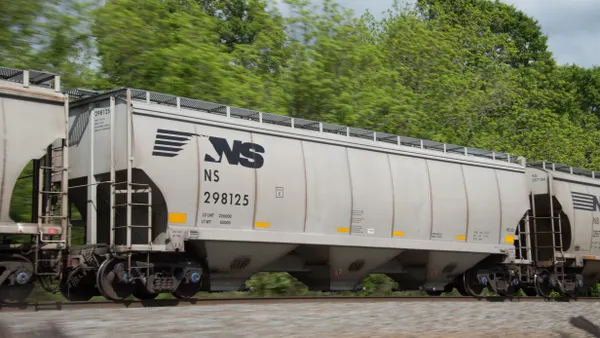Dive Brief:
- Union Pacific (UP) has launched a developer portal that will allow shippers to access data on inbound and outbound rail shipments, the railroad announced this week.
- Three Application Program Interfaces (APIs) provide functions for increased automation, including the ability to release rail equipment without logging into the UP website and alerts when shipments are off course.
- APIs are becoming the preferred communication channel for system integration "because they lay the foundation for systems to more freely and quickly transfer data in real time," UP Director of Information Technologies Lee Sorrick said in a statement.
Dive Insight:
Many carriers are turning to APIs to provide shipment information to customers who ask for more visibility.
Schneider announced its ETAi technology last year, saying its API will provide shippers with real-time updates on order arrival time. "Customers and drivers are in lock-step from the first mile to arrival," Schneider CIO Shaleen Devgun said in a statement, talking about the benefits of the tool.
Ocean carriers are turning to connected containers to track shipments and CMA CGM has said the data collected by these sensors would be made available to shippers through either a web portal or API.
New APIs offered by UP
| API | Function |
|---|---|
| Shipment API | Real-time information on shipments and the estimated time of arrival. |
| Action API | Release of equipment, order-in rail cars, intermodal terminal reservations. |
| Cases API | Notification when a shipment might be off course and could require attention. |
Carriers say this information allows shippers to know when shipments will arrive, but also when and where problems might have occurred.
An API allows the customers to integrate the data stream into existing systems, allowing them to customize it, according to the API company BBVA. It also allows developers, like Loadsmart, to create solutions using the data. Loadsmart has raised millions in funding for its platform that uses an API to connect with port terminal operating systems and match loads to available trucks based on a variety of factors.
The railroad says the connections can also be used for intermodal planning, shipping actions, managing a rail network, validating pre-gate reservations and other functions.
"The goal is to make information access as self-service as possible," Kyle Dyer, UP's principal engineer of information technologies, said in a statement.
As the rail industry has struggled to provide more visibility to customers, the adoption of APIs has been considered a good place to start.
"APIs have gotten a lot of traction in the truck space but not so much in the rail space," Shankar Sengupta, the VP of engineering and transport logistics at GE Transportation, said last year. "This is an area that we are actively working on."














